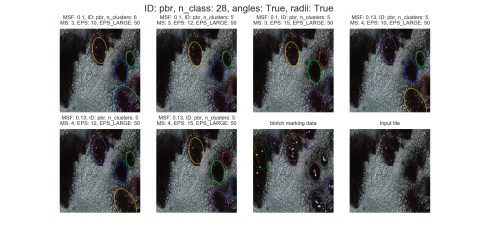Update on the Planet Four: Terrains Paper
A quick update on the Planet Four: Terrains paper. For the past month or so the team has been working on making changes to the manuscript and creating new figures to address the concerns of the two independent referees who reviewed the paper. The referees are experts in the field who assess and critique the paper. Having an independent set of eyes give feedback is useful and makes the paper better. We’ve submitted the revised draft on May 16th with a list of each of the changes we made to address the points raised by the referees. We’re waiting to hear back from the journal. We hope that after this first round of review/edits that there will be only minor changes requested going forward. We’ll have to wait for the referees’ to read the revised manuscript and our report and send their assessment to the editor. Fingers crossed for a speedy review.
As a teaser, below is a new figure we made for the paper. The image is a subframe from a HiRISE observation of one of the regions targeted based on your classifications on Planet Four: Terrains. You can see that this area is like Inca City where we see fans emanating from a top the ice sheet where boulders are embedded/below the ice sheet. Not all the boulders exhibit seasonal fan/carbon dioxide jet activity when this image was taken

Image credit: HiRISE/University of Arizona/JPL
Towards Finalizing the Planet Four Clustering Algorithm
The science team is making great progress towards freezing developing of the Planet Four clustering algorithm. I reviewed some of the output from the pipeline Michael Aye has been writing. Basically the task was to check on the few issues we were working on addressing by having a two size regime clustering for blotches drawn by volunteeers and pick the parameters that seemed to work best for the data.The good news is we see an improvement.
I thought I’d share some of then plots so you so you can see how close we are to finalizing the pipeline. These plots are at the stage of clustering all the blotch markings alone and then clustering all the fan markings alone. We combine the fans and blotch markings into one later on in the process. For now we’ve just run the first part of the clustering pipeline and outputted the results to these figures. As you can see we’re doing pretty well at picking up all the fans and blotches marked by the majority of the classifiers who made a marking on the subject image.
We’ve got one or two more tweaks we brainstormed in the last science team call last week, and once we review those I think we’ll be freezing development on this part of the Planet Four analysis pipeline until after the first paper is submitted.




Progress on the Planet Four blotch clustering
We wanted to give a quick update on the original Planet Four. Michael Aye has been leading the development of the data analysis pipeline. As previously mentioned, we’ve hit a major milestone with completing the fan clustering algorithm for combining your classifications together. We think we’ve now hit that point for finalizing the blotch clustering algorithm.
We think we’ve now got a decent solution for addressing how to cluster very large blotches that take up half the image and very small blotches that are the default blotch circle size. Currently how we’re tackling this is clustering with one linking radius for the center of the blotch markings, and then we run the analysis again using a much larger linking radius. Here’s an example output:

Image credit: Michael Aye
This blotch clustering strategy seems to be a good compromise for our science goals and needs. We’re going to review several more test cases and if all goes well with this step, we will freeze development on the clustering pipeline. That’s one of the last hurdles to applying the pipeline to all of your classifications and dive into what the shapes and sizes and directions of the fans and blotches tell us about the seasonal carbon dioxide jet process and the surface winds in the Martian South Polar region.
